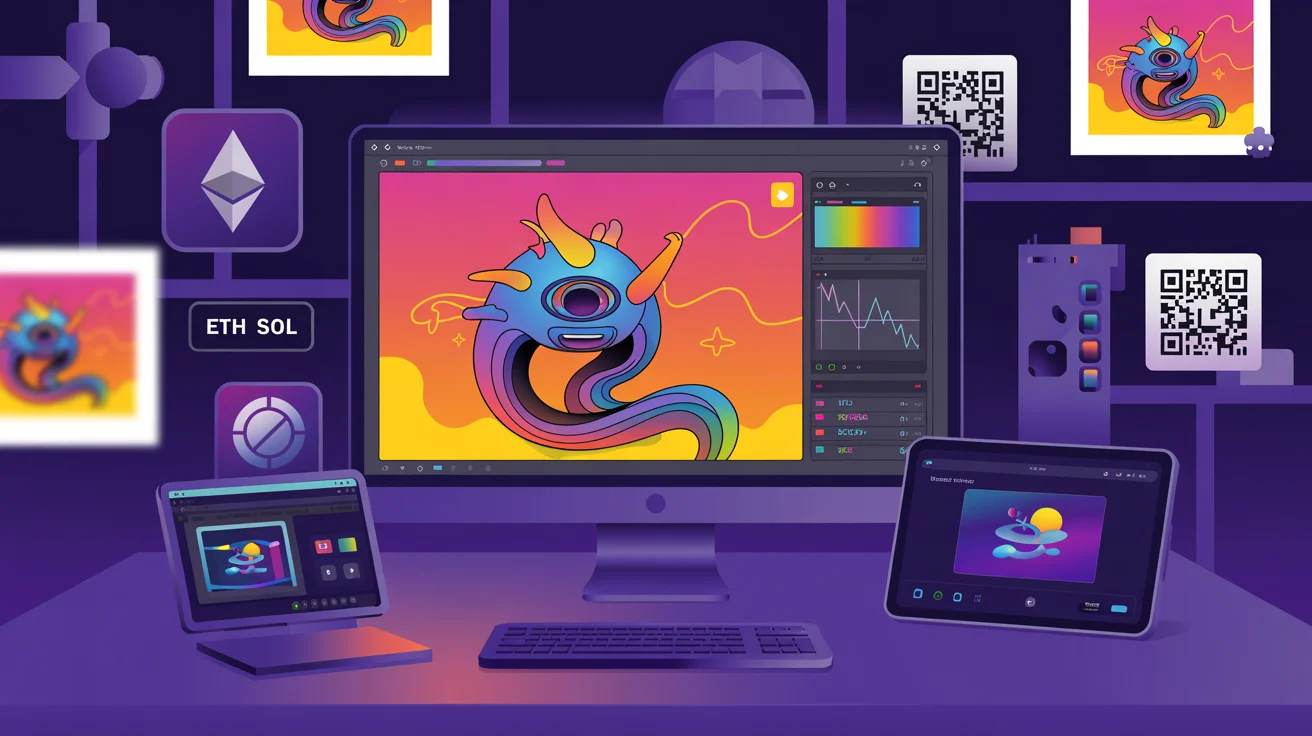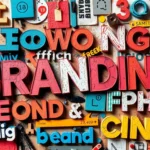Ever wondered how digital artists turn static images into moving masterpieces worth thousands? The world of NFT animation has grown, opening new ways for creators to earn money from their art.
I’m excited to show you how to make animated digital assets. NFT stands for “non-fungible token,” meaning each piece is unique and can’t be replaced. It’s like trading cards – you can swap one for another, but you’ll never have the exact same card again.

Whether you’re an experienced animator or just starting, this guide has you covered. I’ll share the key tools, techniques, and platforms for creating digital art. You’ll learn how to animate and launch your own digital creations.
Ready to make your digital art come to life and earn from your creativity? If you need help, you can hire a skilled freelancer for your animated NFT project.
Table of Contents
Key Takeaways
- NFTs are unique digital assets that cannot be replaced or duplicated
- Animated NFTs typically command higher prices than static digital art
- Creating animated NFTs requires no coding knowledge with today’s tools
- The marketplace for digital collectibles continues to grow despite market fluctuations
- Artists can earn royalties from secondary sales of their animated creations
- Various animation styles and techniques can be applied to NFT projects
What Are Animated NFTs and Why Are They Valuable?
Animated NFTs blend blockchain tech with digital art, giving us dynamic visuals that change before our eyes. They are more than just images; they are moving digital treasures. This makes them very valuable in the digital world.
The Basics of NFTs and Blockchain Technology
Non-fungible tokens (NFTs) are unique digital items verified by blockchain. They are different from cryptocurrencies like Bitcoin, which can be swapped for each other. Each NFT is unique, making it special.
The blockchain is like a digital book that keeps track of who owns what. It makes sure that digital items are scarce and ownership is clear.
But can’t someone just copy digital art? Yes, they can. For example, you could have the Beeple collage that sold for $69 million as your phone background. It’s legal, but it’s not the same as owning the original.
Having a print of the Mona Lisa is like that. You might own a copy, but the original is priceless. The NFT is like a ticket to the original, making it very valuable.
How Animation Adds Value to Digital Collectibles
Animation turns static art into something alive, adding depth and interest. When an NFT moves or tells a story, it connects with viewers on a deeper level.
Creating animations requires skill in design and movement. Artists must know how to make their art move and interact.
Animation offers:
- Stories that unfold over time
- Surprises and hidden elements
- Deeper emotional impact through movement
- More ways to display in digital spaces
These qualities make animated NFTs stand out. They are unique digital treasures that attract collectors in a crowded market.
The Growing Market for Animated Digital Art
The market for animated NFTs is booming. Collectors love these moving pieces, with some selling for hundreds of thousands or even millions of dollars.
Platforms like Foundation, SuperRare, and OpenSea are buzzing with animated digital art. Artists can now sell their work to a global audience of collectors.
Several things are driving this growth:
- More people using digital frames for NFTs
- Appreciation for the skill in animation
- Changes in social media for animated profiles
- More uses in virtual worlds and the metaverse
As blockchain tech improves and more creators join, animated NFTs are at the forefront. They blend art, tech, and investment, making them more than just collectibles. They could be the future of digital ownership.
Essential Tools for Creating NFT Animation
Every successful animated NFT starts with the right tools. Whether you’re new to animated digital collectibles or looking to improve, the right tools are key. They affect the quality and appeal of your work.
Software Options for Beginners and Professionals
The world of animation software has something for everyone. From easy apps for beginners to advanced tools for pros, your choice matters. It shapes what you can create.
2D Animation Tools: Adobe After Effects, Procreate, Spine
For 2D NFT animation, some tools really stand out. Adobe After Effects is top-notch for motion graphics and visual effects. It turns simple art into moving masterpieces.
Procreate on iPad is great for those who love drawing. It’s easy to use and perfect for hand-drawn NFTs. Its natural feel and animation tools are unmatched.
Spine uses a skeletal system for 2D animation. It’s perfect for character NFTs. It saves time and keeps quality high.

3D animation opens new doors for NFTs. Blender is the best free 3D creation suite. It has everything you need, even for complex scenes.
Cinema 4D is known for being easy to learn. It’s great for beginners in 3D animation. Its tools are powerful but easy to use.
Maya is the top choice for high-end 3D animation. It’s more expensive and harder to learn. But it offers advanced features that make your NFTs stand out.
| Software | Dimension | Best For | Price Range | Learning Curve |
|---|---|---|---|---|
| Adobe After Effects | 2D | Motion graphics, visual effects | $20.99/month | Moderate |
| Procreate | 2D | Hand-drawn animation | $9.99 (one-time) | Low |
| Blender | 3D | All-purpose 3D animation | Free | High |
| Cinema 4D | 3D | Beginner-friendly 3D | $59.99/month | Moderate |
| Maya | 3D | Professional 3D animation | $225/month | Very High |
Hardware Requirements for Smooth Workflow
Even the best software needs good hardware to run smoothly. Your computer’s specs affect how well you can create NFTs. They also influence the complexity of your projects.
For serious NFT animation, you need a multi-core processor, at least 16GB of RAM, and a dedicated graphics card. For 3D, you’ll need even more RAM, up to 32GB+ for complex scenes.
Input devices are also key. A good drawing tablet, like a Wacom Intuos, can make a big difference. An iPad Pro with Apple Pencil is great for certain animation styles.
Free vs. Paid Animation Tools: What’s Worth Your Investment
Choosing between free and paid tools depends on your goals, budget, and commitment. Free tools can be a great starting point without financial risk.
Blender is a top example of free software that rivals paid options. Krita is another free tool for 2D animation. Amemori is a free AI photo enhancer on the AppStore that can create animated images quickly.
Paid tools like Adobe Creative Cloud, Cinema 4D, and Maya offer more advanced features. They’re worth it for high-value NFT collections or if animation is your main income.
If you’re overwhelmed or want professional results without the learning curve, consider hiring an NFT animator. Their expertise can save you time and make your NFTs stand out.
Planning Your Animated NFT Project
Starting an animated NFT project takes more than just opening digital tools. It begins with careful planning. This step saves you from frustration and boosts your final product. Let’s explore the key planning stages for a successful NFT art project.
Defining Your Concept and Art Style
Every great NFT project starts with a clear concept and unique art style. Think about your story, the emotions you want to share, and how animation will enhance your message.
Your art style affects who will be interested in your work. Minimalist designs appeal to modern art fans, while detailed designs attract gamers and anime lovers. Abstract styles draw in fine art collectors, and pixel art wins over those who love old-school games.
Make a mood board with images that inspire you. This helps you stay focused and shows your vision to others if you need help from a professional NFT animator.

Creating Storyboards and Animation Sketches
Once your idea is clear, sketch out the animation. Even simple drawings can spot problems before you start animating.
For complex NFT art, I make animatics to check timing and movement. This step is key to seeing how elements will move and transition.
| Storyboard Element | Purpose | Detail Level | Time Investment |
|---|---|---|---|
| Thumbnail Sketches | Quick visualization | Low | 30-60 minutes |
| Keyframe Drawings | Define major movements | Medium | 2-4 hours |
| Animatic | Test timing and flow | Medium | 4-8 hours |
| Detailed Storyboard | Complete visual guide | High | 8-16 hours |
Setting Realistic Timelines and Goals
Animation takes a lot of time. Even a short animation can take days. Break your project into smaller parts with deadlines:
- Concept development: 1-2 days
- Asset creation: 2-5 days
- Animation setup: 1-2 days
- Animation execution: 3-7 days
- Refinement and testing: 2-3 days
Remember, quality animation takes time. Rushing can lead to poor results that won’t impress collectors.
Finding Inspiration in Successful Animated NFT Projects
I study successful projects to see what collectors like. Beeple’s Everydays shows the power of regular updates. XCOPY’s glitch art creates a unique brand.
Look at character-based collections like Cool Cats and Doodles. They teach us about appealing designs and personality. Understanding popular animation styles and marketing strategies helps your project succeed.
The NFT Animation Process: A Step-by-Step Guide
The journey from concept to finished animated NFT is structured. It helps make your artwork shine. Knowing each step helps avoid mistakes and makes your digital collectibles more valuable.
Creating Your Base Artwork and Assets
Begin by making high-quality foundational elements for your animation. Use illustrations, photographs, or 3D models. Make them as high in resolution as you can.
For 2D animation, separate your artwork into layers. This makes it easier to move different parts. In 3D, ensure your models can deform correctly when animated.
Pro tip: Name your layers clearly and group related elements. This keeps your workflow organized as your project gets more complex.
Breaking Down Elements for Animation
Decide which parts of your artwork will move and how they’ll interact. This planning stage is key to a dynamic NFT.
For character animation, rig with bones and controllers. For object animation, prepare pieces for movement. Think about how elements will move together for a cohesive scene.

Adding Movement, Transitions, and Effects
Now, it’s time to bring your artwork to life! Focus on smooth, natural motion that enhances your concept.
Use animation principles like squash and stretch, anticipation, and follow-through. Add transitions and effects like particle systems to boost visual impact.
- Start with simple movements before adding complexity
- Use easing for more natural acceleration and deceleration
- Consider how lighting and shadows change with movement
Testing and Refining Your Animation
Preview your animation at different speeds and angles. Look for jerky movements or timing problems.
Get feedback and be ready to refine multiple times. Small changes can make a big difference in animation quality.
Finalizing Your Animated NFT for Minting
Optimize your animation for minting by adjusting file format and size. Choose a format that balances quality and size, like GIF or MP4.
Make sure your file meets platform requirements while keeping visual quality high. This final step affects how collectors see your animation.
If you’re struggling, don’t hesitate to reach out to a professional NFT animator. They can bring your vision to life with precision.
2D Animation Techniques for Eye-Catching NFTs
To make your animated NFTs pop, you need to know some key 2D animation tricks. These techniques can turn your digital art into something truly eye-catching. They help your work shine in a crowded market and show off your unique style.
Frame-by-Frame Animation for Detailed Movement
Frame-by-frame animation lets you control every detail of your digital art’s movement. You create each frame one by one, making small changes to get smooth motion.
This method takes time but offers incredible detail and character. Adobe Animate, Procreate, and Photoshop are great for it. Drawing each frame by hand is perfect for complex animations or unique effects.
Tweening and Puppet Animation for Efficiency
For quicker animations, tweening and puppet techniques are ideal. Tweening fills in the gaps between key frames, saving time. Puppet animation lets you move your art like a puppet, great for simple actions.
These methods cut down production time without sacrificing quality. They’re perfect for animations like a character waving or a plant moving.
Adding Special Effects and Visual Elements
Special effects can make your animated NFTs truly stand out. Consider adding:
- Particle effects for fire, water, or magic
- Motion blur for speed
- Light effects like glows and flares
- Text animations that show information in a cool way
You can also add shapes, icons, and photos to your animations. Uploading layers from Photoshop files makes animating existing art easier. This layered approach lets you create dynamic and flexible compositions.
Creating Seamless Loops for Continuous Display
Creating perfect loops is key for animated NFTs. Think of your animation like a flip-book, where the last frame smoothly connects to the first.
To make seamless loops, plan your animation carefully. Move elements gradually to ensure smooth effects. Most animation software has a bottom bar for creating new pages that become frames when exported.
When exporting, GIFs are widely supported but have color limits. For better quality, use MP4 or WebM if your platform allows it. Remember, file size impacts both display and minting costs.
Need help with your animated NFT vision? Consider hiring a professional NFT animator. They can use these techniques to create standout digital collectibles.
Exploring 3D NFT Animation Methods
Creating 3D animated NFTs opens up new ways to express art. Artists can make digital worlds with real lighting, textures, and movement. This is different from 2D animation, which lacks depth and perspective.

Modeling and Texturing Your 3D Assets
Modeling is the first step in making 3D animated NFTs. You use software like Blender, Cinema 4D, or Maya to create your digital objects. Start with basic shapes and then add details.
Texturing makes your models look real by adding surface properties. Good textures include color, reflectivity, and roughness. Even simple models can look amazing with the right textures.
| 3D Software | Best For | Learning Curve | Price Range |
|---|---|---|---|
| Blender | All-purpose 3D creation | Moderate | Free |
| Cinema 4D | Motion graphics | Moderate | $59.99/month |
| Maya | Professional animation | Steep | $225/month |
| ZBrush | Detailed sculpting | Steep | $39.95/month |
Rigging and Character Animation Basics
Rigging is key for 3D animated NFTs with moving characters or objects. It involves creating a digital skeleton that controls how your model moves. Think of it as the puppetry system for your digital creation.
Weight painting and timing are important for natural-looking animations. Even simple animations can look great with the right rigging.
Lighting and Rendering Your 3D NFT
Lighting greatly affects your 3D animated NFTs’ look. Try different lighting setups to set the mood and highlight key parts. HDRI environments can add realistic reflections and depth.
When rendering, balance quality with practical needs like file size and time. Use options like Cycles or Eevee in Blender to find the right balance. Higher quality renders need more storage and may cost more to mint.
Combining 2D and 3D Elements for Unique Effects
Hybrid techniques that mix 2D and 3D can make your NFTs stand out. You can use 3D elements with 2D textures, overlay 2D effects, or combine 2D characters with 3D environments.
New to 3D animation? Consider hiring a professional 3D NFT animator. They can help bring your vision to life with their expertise and efficient workflow.
Optimizing File Formats for NFT Animation
Every animated NFT starts with a key decision: the file format. It’s a balance between looking good and being practical for the blockchain. I’ve made many animated NFTs and learned that the format affects how people see your work and the minting cost.
GIF vs. MP4: Pros and Cons for NFT Display
Choosing a format is a tradeoff. GIFs are compatible everywhere and work well for simple animations. They’re great for pixel art and cartoons.
But GIFs have limits. They only support 256 colors, can’t have audio, and are bigger for complex animations.
MP4 and other videos offer better quality and color depth. They can include audio and compress better for detailed animations. But, not all platforms support them yet.

Balancing Quality and File Size Constraints
For most NFTs, aim for 1080×1080 to 1500×1500 pixel resolutions. Frame rates of 24-30fps are smooth without being too big.
Higher resolution and frame rates make animations better but bigger. Finding the right balance is key for your digital asset.
Compression Techniques to Reduce Gas Fees
To cut down on minting costs, use these compression tips:
- For GIFs: Use fewer colors
- Limit frame rates to 15-24fps
- Try dithering for more color illusion
- For MP4: Adjust the bitrate for size and quality
- Use H.265 codecs for better compression
After making your animation, export it as a video or GIF.
Testing Your Animation Across Different Platforms
What looks great on your computer might not on mobile or marketplaces. Always test on different devices before finalizing.
If allowed, upload a high-quality “display” version and a smaller “on-chain” version. This way, you get the best of both worlds.
Need help with NFT animation formats? Consider hiring a professional NFT animator who knows the technical needs of different platforms.
Minting Your Animated NFT on the Blockchain
Once your animation is ready, it’s time to mint it on the blockchain. This step turns it into a real NFT. It creates a permanent record of ownership and makes your digital art valuable.
Preparing Your Files for Blockchain Compatibility
Before minting, make sure your animation files are ready for the blockchain. Most platforms accept GIF, MP4, or WEBM formats. Your file should have a title, description, and unique properties.
Also, create a high-resolution image for your NFT’s thumbnail. This first look can really grab buyers’ attention.

Step-by-Step Minting Process on Different Platforms
To mint your animation, follow these steps:
- Purchase cryptocurrency (usually Ethereum or Solana) from a trusted exchange
- Move your crypto to a digital wallet like MetaMask or Coinbase Wallet
- Sign up on an NFT marketplace like OpenSea or Rarible
- Link your wallet to the platform
- Upload your animation and add all metadata
- Start the minting process
Each platform has its own features. Ethereum-based sites like OpenSea offer “lazy minting” with no upfront fees. Solana-based sites like Magic Eden have faster, cheaper transactions.
If minting seems hard, you can hire a pro NFT animator to help or do it all for you.
Setting Royalties and Pricing Strategies
NFTs let you earn royalties from future sales. Most platforms let you set royalties between 5-10%. Some even let you take up to 50% of secondary sales.
When pricing your NFT, think about your long-term goals. A high initial price might look good, but a lower price with good royalties can earn more over time.
Understanding Gas Fees and Timing Your Mint
Gas fees are costs on the Ethereum blockchain. They can be high, sometimes over $100 per transaction. These fees change based on how busy the network is.
To save money when minting and selling:
- Watch gas prices with tools like Etherscan or Gas Now
- Mint during quiet times (weekends and late nights in US)
- Look into layer-2 solutions like Polygon or other blockchains like Solana
- Consider batch minting for multiple pieces
Timing your mint right can save money and get more visibility. This is when marketplaces are busiest and collectors are most active.
Best Marketplaces for Selling Your NFT Animation
After minting your animated NFT, picking the right marketplace is key. It should match your art and business goals. The platform you choose can boost your visibility, sales, and connect with collectors who love animated digital art.
OpenSea: Features and Benefits for Animated NFTs
OpenSea is the biggest NFT marketplace with lots of trading and users. It supports GIF and MP4 formats for animated NFTs. You can mint on Ethereum or Polygon, which has lower fees.
The platform takes a 2.5% fee on sales and lets you set royalties up to 10%. OpenSea’s size means more buyers but also more competition.

Rarible, Foundation, and Other Specialized Platforms
Rarible focuses on community with its RARI token. It supports animated NFTs and offers “lazy minting” to save on gas costs. To start on Rarible:
- Sign in and connect your wallet at Rarible.com
- Click “Create” and choose your blockchain
- Enter price and royalty percentage
- Choose a collection or create one
- Click “Create Item” to finish
Foundation is an exclusive, curated marketplace for top art. It’s more selective but can sell pieces for higher prices.
Other great platforms include SuperRare for unique 1/1 art, Nifty Gateway for curated drops, and KnownOrigin for artist-focused features.
Choosing the Right Marketplace for Your Animation Style
When picking an NFT exchange, think beyond size. Abstract animations might do well on Foundation or SuperRare. Character-based or collectible animations often thrive on OpenSea or Rarible.
Also, consider technical aspects like file formats, sizes, and blockchain options before choosing a platform.
Creating Collections vs. Individual Animated Pieces
Decide if you want to sell collections or individual pieces. Collections can build a brand and encourage collectors. Individual pieces offer more freedom and can sell for higher prices.
Many creators mix both, making themed collections of unique pieces. This approach combines brand building with creative freedom.
If you’re unsure about these choices or need help with your animated NFTs, consider hiring an experienced NFT animator. They can help bring your vision to life and guide you through selling.
Marketing and Promoting Your Animated NFTs
In the world of crypto art, getting noticed is key. Even the most beautiful animations need smart marketing to find their audience. This is how you maximize their value in the market.
Building a Community Around Your Animated Work
Having a dedicated community is vital for success in NFTs. Share your creative journey and the stories behind your animations. This makes collectors feel connected to your work.
Here are some ways to build your community:
- Start a Discord server for fans to talk directly with you
- Host AMAs (Ask Me Anything) sessions regularly
- Give early supporters exclusive previews
- Share behind-the-scenes content of your animation process
Leveraging Social Media Platforms for Maximum Exposure
Each social media platform has its own strengths for promoting your crypto art. You need a strategy for each to showcase your animated NFTs well.
| Platform | Best Content Types | Posting Frequency | Key Features | Audience Engagement |
|---|---|---|---|---|
| Short clips, announcements, threads | 3-5 times daily | Hashtags, Spaces, NFT community | Replies, quote tweets, spaces | |
| Process videos, final animations | 1-2 times daily | Reels, Stories, visual gallery | Comments, DMs, story interactions | |
| TikTok | Creation process, tutorials | 1-3 times daily | Algorithm reach, trending sounds | Duets, comments, shares |
| Discord | Exclusive drops, community events | Daily activity | Direct community management | Voice chats, channels, roles |
Use Twitter and hashtags like #NFT, #AnimatedNFT, and #CryptoArt to get noticed. Join in on events like #NFTThursday to meet collectors.
Collaborating with Other Artists and Collectors
Working with others can expand your reach in NFTs. Look for artists whose style complements yours but appeals to different people.
Here are some collaboration ideas:
- Make joint animated projects that mix your styles
- Join curated collections or drops
- Do cross-promotions where you show each other’s work
- Build relationships with collectors who can promote your work
Collectors can be your biggest supporters. Keep them happy with special perks like airdrops or private channels.
Need help with your NFT animation?
Struggling to make professional animations or lacking skills? Consider experts. Video Igniter Animation offers custom video production for stunning NFTs.
Their online team works faster and cheaper than traditional studios. They can do 2D or 3D animations. Professional services make your work stand out and command higher prices.
Investing in professional animation boosts your work’s quality. It also increases its monetize value in the competitive crypto art world.
Overcoming Common Challenges in NFT Animation
Animated NFTs are exciting but come with challenges. The journey from idea to collectible NFT isn’t always easy. But, with the right strategy, you can overcome these hurdles.
Technical Issues and Troubleshooting Tips
Software crashes and rendering problems are common. If your animation freezes, try simplifying your project or breaking it into smaller parts. If your software isn’t working well, think about upgrading your computer’s RAM or graphics card.
When minting issues happen, check that your files and sizes are right for the market. Always have enough money in your crypto wallet for gas fees and a little extra. If transactions fail, wait a bit before trying again. Blockchain congestion might be the reason.
Standing Out in a Competitive Marketplace
The NFT collection space is getting busier every day. To stand out, create something unique. Focus on making a few high-quality pieces instead of many low-quality ones.
Make animations that tell stories or use new techniques. A consistent style in your NFT artworks helps collectors recognize your work.
If finding your unique style is hard, consider hiring a professional NFT animator. They can bring a fresh perspective to your ideas.
Dealing with Market Fluctuations and Trends
The cryptocurrency and NFT markets can change quickly, affecting your sales. Create pieces at different price points to attract different buyers.
Keep up with market trends but don’t follow every new thing. By the time you make something based on a trend, it might be over. Focus on earning from royalties from secondary sales, not just the initial mint price.
Protecting Your Animated Work from Copycats
Blockchain verification proves you own your work, but it can’t stop visual copying. Add unique signature elements, like hidden details or special animation sequences, to your NFT artworks.
Use watermarked preview versions and keep the best quality for buyers. For your most valuable pieces, consider formal copyright registration for extra protection.
Building a community that values your work is a great way to fight against copying. Teach your collectors about the special aspects of your animations. This helps them see the value in the real thing.
Conclusion
In this guide, we explored how to make animated NFTs that catch the eye in the blockchain world. The digital art scene is growing fast. It gives artists a chance to show their creativity and make their work rare.
NFTs are special because of the art behind them, not just the tech. Your unique style and creativity are key to success. Whether you make simple GIFs or complex 3D animations, always aim for quality and truth.
The NFT market is booming, with more artists selling their digital art online. By following this guide, you can turn your digital art into valuable NFTs. Remember, different platforms suit different styles and audiences.
Keep up with the fast-changing world of NFTs. New tech, marketplaces, and trends come out all the time. This opens up new chances for creative people. Combining art skills with tech knowledge will help you succeed.
Want to bring your NFT vision to life but need help? Think about working with a pro NFT animator. They can help you solve technical problems and create amazing digital collectibles that people will value.
FAQ
For “NFT Animation: How to Animate & Make an Animated NFT”
Q: How do I make an animated NFT?
A: To make an animated NFT, start by choosing animation software like After Effects, Blender, or Procreate. Create your animated artwork in formats such as GIF, MP4, or WebM. Then choose a blockchain platform (Ethereum, Solana, etc.), set up a crypto wallet, and connect it to an NFT marketplace like OpenSea or Rarible. Finally, mint your animation as an NFT by following the marketplace’s upload process, set your price, and complete the transaction. Remember that minting costs (gas fees) vary depending on the blockchain you choose.
Q: What software should I use to create animated NFTs?
A: There are several excellent options to create an animated NFT depending on your skill level. Professional animators often use Adobe After Effects, Blender, or Cinema 4D for complex animations. For beginners, user-friendly options include Procreate (iPad), Adobe Animate, or Clipstudio Paint. For pixel art animations, consider Aseprite or Pixel Studio. Web-based tools like Canva or Crello also offer basic animation features. Choose software that matches your technical abilities and the style of animation you want to create for your unique NFT.
Q: Which NFT marketplace is best for selling animated NFTs?
A: The best NFT marketplace for your animated artwork depends on your goals. OpenSea is the largest platform with high visibility but significant competition. Foundation and SuperRare are curated platforms offering higher-quality art and potentially better prices. Rarible allows custom royalties, while Nifty Gateway hosts “drops” with major artists. For lower fees, consider Solana-based marketplaces like SolSea or Magic Eden. Research each platform’s audience, fees, environmental impact, and promotion options to find the right NFT marketplace that aligns with your animation style and business goals.
Q: Do I need to be a professional animator to create valuable NFTs?
A: No, you don’t need to be a professional animator to create valuable NFTs. While technical skill can help, many successful NFT creators started as hobbyists. What matters most is creating something unique with an interesting concept, style, or story. Simple animations with distinctive character designs or aesthetics often perform better than technically complex but generic work. Focus on developing your unique artistic voice and building a community around your work. Many platforms offer user-friendly tools that allow beginners to create an animated NFT without advanced skills. Consistency and authenticity often matter more to NFT enthusiasts than professional-grade execution.
Q: What are the best NFT animation services for beginners?
A: If you’re new to creating NFTs and lack animation skills, several NFT animation services can help. Fiverr and Upwork host freelance animators at various price points. Companies like Pixel Plex and NiftyKit offer specialized NFT animation services from concept to minting. No-code platforms such as Appy Pie Animation and Canva provide templates to create an animated NFT without technical knowledge. NFT generation services like NFT Art Generator can create multiple variations from base assets. For learning, platforms like Skillshare and Udemy offer courses specifically on NFT animation. These services can help you enter the market while you develop your own skills.
Q: How can I monetize my animated NFTs beyond the initial sale?
A: To monetize your animated NFTs beyond initial sales, set up royalties to earn from secondary market transactions (typically 5-10%). Create limited edition series or collections to build scarcity and collector interest. Offer exclusive content or membership benefits to NFT holders. Consider animation licensing for commercial use while retaining NFT ownership. Collaborate with brands looking to enter the NFT space. Create narrative-based collections where owning one NFT encourages collecting others. Participate in virtual galleries and metaverse exhibitions to increase visibility. You can also offer NFT staking where collectors earn rewards for holding your art and collectibles long-term. Building a community around your work creates sustained value beyond individual sales.
Q: What file formats work best for animated NFTs?
A: For animated NFTs, the most widely supported formats are GIF, MP4, and WebM. GIFs are universally compatible but have limited color depth and larger file sizes. MP4 offers better quality and compression but check marketplace-specific limitations on file size and length. WebM provides excellent compression while maintaining quality. Some platforms also support more specialized formats like GLB/GLTF for 3D animations. Always verify the specific requirements of your chosen NFT platform before finalizing your animation. Consider creating multiple versions of your animated video in different formats to ensure compatibility across platforms and to provide options for collectors with varying technical capabilities.
Q: How are animated NFTs different from traditional art and collectibles?
A: Animated NFTs differ from traditional art and collectibles in several key ways. Unlike physical art, they exist digitally on blockchain technology, providing verifiable proof of ownership and authenticity. Animated NFTs introduce movement and time-based elements impossible in static art forms. They can include interactive features or evolving components that change over time. Creator royalties are automatically enforced through smart contracts, allowing artists to profit from secondary sales. They’re easily tradable globally without shipping or storage concerns.
Animated NFTs can also serve as access tokens to exclusive communities or experiences. While physical art depends on condition preservation, digital artworks maintain their original quality regardless of age. This new trend represents a fundamental shift in how we create, value, and collect art.
Q: What makes an animated NFT valuable?
A: Several factors contribute to an animated NFT’s value. Artist reputation and previous sales history play a significant role, as does the animation’s visual appeal and technical execution. Scarcity matters—limited editions or one-of-one pieces typically command higher prices. Cultural relevance and storytelling elements can create emotional connections with collectors. Utility beyond the artwork itself, such as access to exclusive communities or experiences, adds practical value. Historical significance as an early example of a style or technique can increase worth over time. Community engagement and active collector interest sustain long-term value, as does the animation’s distinctiveness compared to other NFTs. The right NFT marketplace choice and proper marketing also significantly impact an animated NFT’s perceived value.
Q: What are the biggest challenges when creating animated NFTs?
A: Creating animated NFTs comes with several challenges. Technical barriers include learning animation software and understanding blockchain technology. File size limitations on NFT platforms may restrict animation length or quality. Gas fees (transaction costs) can be prohibitively expensive, especially on Ethereum. Market oversaturation makes standing out increasingly difficult. Copyright issues arise when using third-party assets or music. Environmental concerns about blockchain energy consumption affect some collectors’ willingness to buy. Finding the right balance between artistic vision and marketability can be tricky. Marketing effectively requires building a social media presence and community. Finally, keeping up with rapidly evolving platform requirements and market trends demands constant adaptation. Success requires navigating these challenges while maintaining artistic integrity and business savvy.
Related Articles:
- 3D Animation Character Rig : Skeletal Animation Explained
- Animations for Streamers: Custom Twitch Stream Overlays, Animated Alerts & Designs
- How to Make Animation for Kids? Animation Basics: Animate with Stop Motion
- Top Strategies for Using Animated GIFs to Boost Social Media Post and Engagement
- Effective Character Animation: Animate Characters & Animator Tools
- How do VTubers Get Their Avatars? The Ultimate VTuber Avatar Guide
This post contains affiliate links, which means I may earn a commission if you make a purchase through these links. There is no additional charge to you! Thank you for supporting my blog so I can continue creating free content each week!





